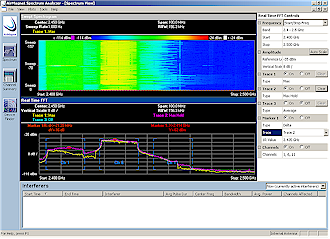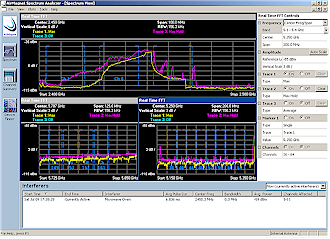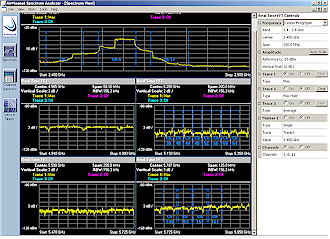In Use, Continued
The microwave was "bursty" because I kept turning it on and off to see how long it took ASA to detect it both coming and going. I found it took between 15 to 30 seconds from microwave on to an Interferer notification and about the same time from microwave off to when the Interferer notification went away. ASA will keep up to 24 hours of Interferer logs, which you can view by changing the drop-down selection. But note that Interferer logs aren't saved if you shut down the program.

Figure 9: Two WLANs on Channels 1 and 6
(click image to enlarge)
Figure 9 shows the spectrum captured from two WLANs that I set up in the same room on Channels 1 and 6. What's interesting here is that while both APs were about 3 feet apart on an open shelf and within 6 feet of both clients, there is a 16dB - about 40 X - difference between the Channel 1 and 6 signals.
I attribute the difference to the fact that the Channel 6 client was a notebook right beside the ASA notebook, while the Channel 1 client was a CardBus card in a CardBus-to-PCI adapter inserted into a PCI slot in the back of a desktop PC. A pretty convincing demonstration of why external antennas are a must for PCI-based wireless adapters!
Tip: I used the Delta Marker feature to take the above reading. There's also a Single Marker that you can position at any monitored frequency - either by dragging the marker, using left and right arrow keys or entering the desired frequency directly - that displays frequency and amplitude at the marker.

Figure 10: Three bands w/ microwave interferer
(click image to enlarge)
Figure 10 shows one of ASA's key advantages over BVS' handheld devices. The larger screen real-estate of the notebook screen makes it possible to monitor multiple bands simultaneously - in this case the U.S. 802.11a, b and g bands. I actually grabbed this plot with the ASA notebook back in my office and the microwave running in the kitchen - two sheetrock walls and about 30 feet away. Since this time the microwave was running for a few minutes, I had plenty of time to capture the entry in the Interferer log.
I also took the ASA to all the WLAN test locations throughout my home while steady Channel 6 test signal was cranking away and found the ASA's sensitivity was roughly in line with current-generation 11g WLAN cards.

Figure 11: All five bands
(click image to enlarge)
And as a final example of the ASA's power, Figure 11 shows all five bands that it is capable of simultaneously monitoring. Actually, it can cover six bands, but since the 5.49 - 5.71GHz EMEA Middle (802.11 channels 100 - 140) and 5.47 - 5.725 GHz UNII bands overlap, you can't do both simultaneously.
One thing I did notice, however, after gazing at this display for a minute or so is that all plots don't consistently update each second. The 2.4 to 2.5 GHz plot seems to consistenly update every second, but the 5GHz band plots seem to skip a second or two, sometimes occasionally, or in the setup shown in Figure 10, updating only every three seconds. But even with this little glitch, this is pretty impressive capability!
I should note that I didn't find the Air Quality plots - Duty Cycle, Log Power Average, Maximum Power, Pulse Duration, Pulses Per Second, Max Interfer Power, and Interferer Duty Cycle - very informative for my little test WLAN. But with busier airwaves to work with, I'm sure they'll provide further insight to those more skilled in RF analysis.